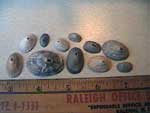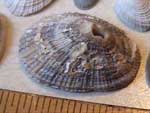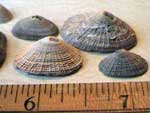Photos of Keyhole Limpets, Diodora cayenensis, scientific classification and general information on habitat and range..

Cayenne keyhole limpet Diodora cayenensis


Keyhole Limpet #01
2816 x 2112 pixels
Top Shaped - keyhole limpets (Fissurellidae)
Cayenne keyhole limpet Diodora cayenensis (Larmarck)
Description: (1 inch) Shell shaped like a small, low cone or a coolie hat. Many ribs radiating from the small, subcentral keyholelike opening on top of shell. Inside of keyhole opening outlined by a truncate callous with a deep pit on its concave edge.
Color: Exterior white and pinkish gray or brown. Interior white to gray.
Habitat: Lives in inlets and offshore waters attached to rocks or shells. Occasionally found on sound and ocean beaches.
Range: New Jersey to Brazil.
Notes: Also called a little keyhole limpet. A herbivore, it uses radula to scrape algae off of rocks. Its powerful foot creates strong suction to keep waves from washing it off the rocks. Water enters under the edge of the shell and exits through the "keyhole" near the peak. Its eggs are yellow and stick to rocks. Hatched young crawl away.
Source: Seashells of North Carolina, North Carolina Sea Grant College Program
These are photographs of the keyhole limpets I've found along the beaches to date, some small and some larger. The keyhole limpet is classified under Gastropods, and comes in the form of this one unusually-shaped shell.

Keyhole Limpet #02
2816 x 2112 pixels

Keyhole Limpet #03
2816 x 2112 pixels

Keyhole Limpet #04
2816 x 2112 pixels

Keyhole Limpet #05
2816 x 2112 pixels
Enlarge images to 320 pixels by clicking thumbnails
 |
 |
 |
 |
 |
 |
 |
 |
 |
 |
 |
 |
 |
 |
 |
 |
 |
 |
 |
 |

Keyhole Limpet #06
2816 x 2112 pixels

Keyhole Limpet #07
2816 x 2112 pixels

Keyhole Limpet #07
2816 x 2112 pixels
References and Further Reading
Natural History, February 2001
it is simply a terrible design! Unlike most mollusks [for the most part] who can close up inside, or withdraw into their shell for protection, not so easy for the limpet. [there's other bad designs, where some species like barnea truncata the Fallen Angelwing, if I'm not mistaken is another species, almost as bad as limpet design, can not completely close their shell]... which would seem to leave them vulnerable to predators. Notice the curve near the hinge of the shell...
the keyhole limpet is an obscure little shell I've been collecting and I've been asking myself the same questions
Dead in sand, Mayport Naval Station
(Lamarck, JBPA de, 1822), Cayenne Keyhole Limpet ... Diodora microsticta Dall, WH, 1927. Academy of Natural Sciences, Philadelphia, USA
Diodora cayenensis (Lamarck, 1822). Range: 39°N to 28°S; 97.6°W to 15°W Depth: 0 to 100 m (live 0 to 46 m) Maximum Reported Size: 51 mm
Species, Diodora cayenensis (Lamarck, 1822) -- Cayenne keyhole limpet
Notes:. Reference for:, Diodora cayenensis
Family Fissurellidae Diodora cayenensis (Lamarck, 1822) Cayenne keyhole limpet - 35 mm.
Shell elevated, elliptical. Keyhole elongate.
M-810 KEYHOLE LIMPET, Diodora cayenensis, a primitive uni-valve gastropod. The conical shell resembles a coolie hat. Moves freely over rock or shell
Species Name: Diodora cayenensis. Common Name / Nombre Común: Cayenne keyhole
Mollusca, Gastropoda, Vetigastropoda, Fissurellidae, Diodora, cayenensis

a bad design this will never be, as these shells are being used for the cure for cancer... much much love.i live in lajolla california and collect them for the beauty and fun of it.. now, after researching them deeply, find out they are curing cancer.. amazed
ReplyDelete